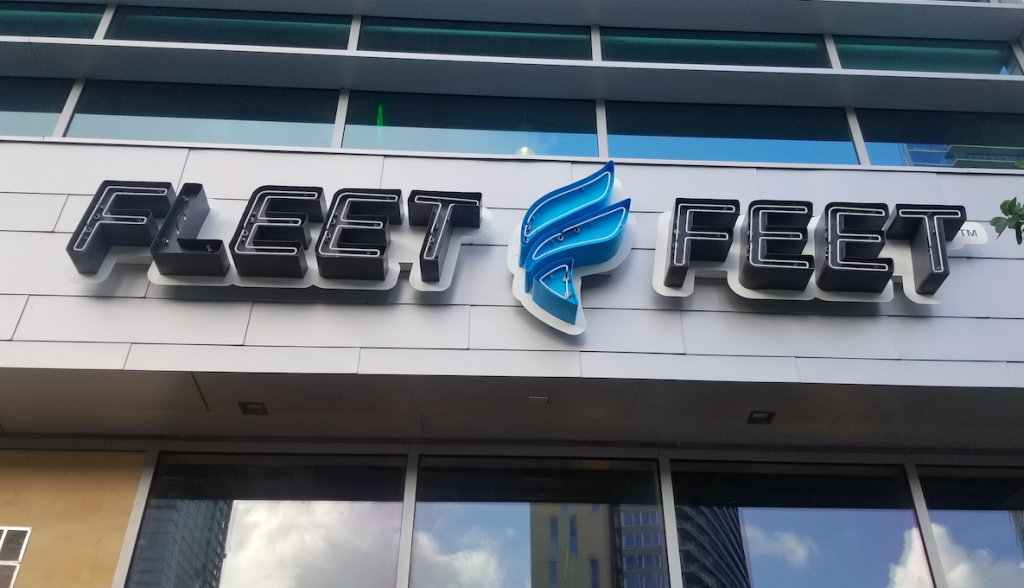Fleet Feet has been busy, acquiring Boston’s Marathon Sports last year on top of its 2021 acquisition of the JackRabbit chain. Here, Joey Pointer, CEO, discusses the reasons behind the Marathon Sports’ acquisition and its ongoing expansion appetite, its recent performance, key initiatives and more.
 The big news for 2022 was the acquisition of Marathon Sports. Can you talk about what drove the acquisition and what the acquisition means for Fleet Feet? The acquisition of Marathon Sports was really driven by Colin and Penny Peddie’s retirement. For 30 years, Colin was an extremely influential industry leader. Together, he and Penny built an incredible team and organization, so when we were presented with an opportunity to become a part of their iconic running brand, we knew we wanted to be involved as a part of our effort to serve more running communities.
The big news for 2022 was the acquisition of Marathon Sports. Can you talk about what drove the acquisition and what the acquisition means for Fleet Feet? The acquisition of Marathon Sports was really driven by Colin and Penny Peddie’s retirement. For 30 years, Colin was an extremely influential industry leader. Together, he and Penny built an incredible team and organization, so when we were presented with an opportunity to become a part of their iconic running brand, we knew we wanted to be involved as a part of our effort to serve more running communities.
We approached our investment in Marathon Sports in a totally different way than we did when we acquired JackRabbit, with the goal of preserving the legacy and identity of the Marathon Sports brand in New England. We decided not to integrate the two brands, instead keeping Marathon Sports as a wholly-owned subsidiary with digital operations, purchasing, vendor management, marketing, and retail operations all running independently of our Fleet Feet operations.
Ben Cooke is excelling in his new role as president of the Marathon Sports brand and it’s been exciting to watch him grow and take on a new challenge and more responsibility. Since the acquisition, I’ve had the opportunity to spend more time with the Marathon Sports management team. People form the DNA of any brand and this is an amazing team of deeply talented and passionate people. I’m excited to have them join our larger organization and see them thrive.
A personal highlight to me was watching how the Marathon Sports team welcomed the running world to Boston over the marathon weekend. The team did an incredible job of partnering with brands, other retailers and influencers to put on an amazing week of events and activations. I am not sure of another running store that sits at the literal finish line of a major marathon. The energy and excitement in the city around the event was incredible, and will hopefully be a great early indicator that running will have a strong year in 2023.
Fleet Feet now has over 250 locations with JackRabbit adding 57 locations and Marathon Sports, 18. Are you still looking to grow? We’re on the path to becoming a 100-year brand, and as a part of that, want to see our footprint grow to 400 stores, allowing us to serve even more running communities across the country. This year, we’re on pace to open an additional 18 doors. Today, about 40 percent of our stores are company-owned while 60 percent are franchise-owned. In addition to the JackRabbit and Marathon Sports acquisitions, nine franchise locations opened last year, which is where we’ll continue to focus as new and existing owners open more stores, reinforcing Fleet Feet as the best national resource for local running.
How was Fleet Feet’s performance in 2022? Did you find growth on an organic basis? Systemwide sales were strong, up 42 percent last year. Our brick-and-mortar stores continue to be the epicenter of our brand and we use that as a key indicator of our brand’s health. Last year, we once again saw double-digit comp-store sales growth. Additionally, we had balanced growth with e-commerce also seeing robust gains.
Any brand or category highlights? On the footwear side, our big three were Hoka, Brooks and On. The real winner in 2023 will be the consumer, as product quality and footwear innovation are as high as we’ve seen. It will be interesting to see how the legacy brands remerge. For instance, ASICS products have been rejuvenated and customers are loving them. On the apparel side, Rabbit and Vuori had a big year and we expect both brands to continue to gain traction.
Can you highlight some key initiatives or programs that you have set for 2023? This year, our strategy will focus on re-engaging runners to participate in our training programs and creating more opportunities for retention and loyalty. More to come. From a talent perspective, our focus is on identifying, hiring and retaining top talent. Last year, we launched an internship program for HBCU students, and look forward to expanding both the program and our intern roster this year. We also established Employee Resource Groups to elevate the voices of underrepresented communities within our employee base, and launched an internal Mentorship Program, stepping away from the traditional structure to focus on reverse mentoring, allowing greener employees to lead as mentors.
What’s your outlook for the run business in 2023? Any concerns about participation or inflation or any run specialty-specific concerns? Several challenges face our industry but they’re not necessarily unique to run specialty – they’re challenges for most retailers and businesses alike. Economic headwinds will need to be closely monitored; staffing will continue to require thoughtful attention and consideration; and, we’ll need to continue to strategically navigate and manage inventory and the sheer amount of product available with our vendor partners. With all that said, I don’t have concerns with participation. The pandemic really opened people up to the health benefits of running and walking regularly, regardless of if that’s through a neighborhood, on a trail or in a gym, and I believe that will only continue to grow.
Photos courtesy Fleet Feet
















